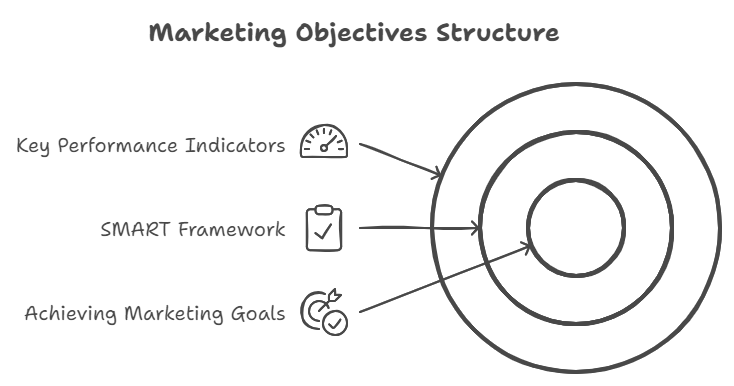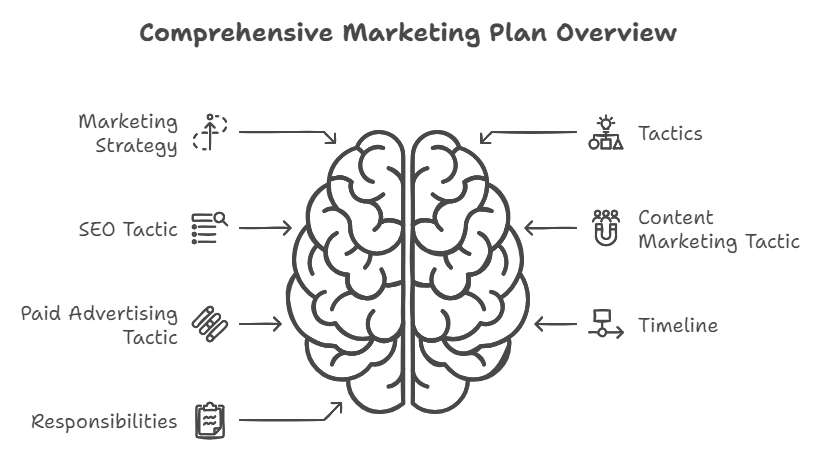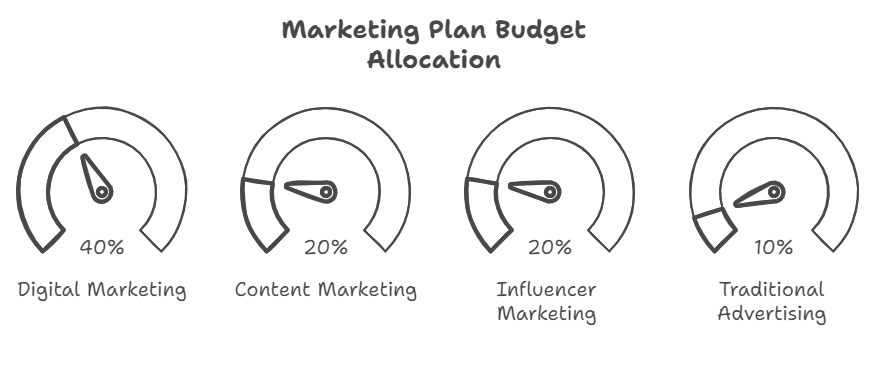Introduction
A marketing plan layout refers to the structured format or organization of a marketing plan, designed to ensure that all the essential elements are clearly presented and easily accessible. Having a well-organized layout is critical to the success of any marketing plan, as it brings clarity and cohesion to the strategy. A structured layout not only keeps the plan organized but also ensures that all team members and stakeholders are aligned in understanding the goals, tactics, and timelines involved.
An effective marketing plan layout improves communication, helps track progress, and provides a clear roadmap for executing the strategy. It ensures that every aspect of the plan, from high-level objectives to detailed tactics, is clearly defined and easy to follow. Without a proper layout, teams may become disorganized, leading to inefficiencies, miscommunication, and the potential failure to meet objectives.
Executive Summary
The executive summary is the starting point of any well-structured marketing plan layout and serves as a concise overview of the entire plan. It provides a snapshot of the marketing goals, target audience, and key strategies, offering stakeholders a quick reference to the core elements of the plan. This section is typically no more than a page long, ensuring that it captures only the most important and actionable insights.
The main purpose of the executive summary is to set the tone for the rest of the plan, giving readers a clear understanding of what the plan seeks to achieve. It should outline:
- The overall marketing objectives (e.g., increase brand awareness, boost sales, or enter new markets).
- The primary target audience the marketing efforts are aimed at.
- A brief summary of the key marketing strategies and tactics that will be employed to reach those goals.
This section is especially useful for high-level stakeholders, such as executives or investors, who may not need to dive into the details but require a clear understanding of the marketing direction. By starting with a well-crafted executive summary, you ensure that everyone is on the same page from the very beginning.
Situation Analysis

A thorough situation analysis is a critical component of any marketing plan layout, as it forms the foundation for all strategic decisions that follow. This section involves evaluating the current market conditions, analyzing the competitive landscape, and conducting a SWOT (Strengths, Weaknesses, Opportunities, and Threats) analysis. These elements help businesses understand their position in the market, identify potential challenges, and uncover opportunities for growth.
- Current Market Conditions: This part of the situation analysis examines key industry trends, consumer behaviors, and economic factors that may impact the business. Understanding these factors helps companies anticipate market shifts and adjust their strategies accordingly.
- Competitor Landscape: This subsection involves analyzing the strengths and weaknesses of major competitors. Knowing what competitors are doing well (or poorly) can inform the company’s strategy and help it differentiate itself in the marketplace.
- SWOT Analysis:
- Strengths: Internal factors that give the company a competitive advantage (e.g., strong brand reputation, superior product quality).
- Weaknesses: Internal limitations or challenges that could hinder success (e.g., limited resources, weak customer service).
- Opportunities: External market opportunities the company can capitalize on (e.g., growing demand for a specific product, untapped markets).
- Threats: External risks that could negatively affect the business (e.g., new competitors, changing regulations).
By including a detailed situation analysis in the marketing plan layout, businesses gain valuable insights that guide their decision-making. This section ensures that the strategies developed later in the plan are based on a deep understanding of the market environment and are designed to address real challenges while leveraging potential opportunities.
Marketing Objectives and KPIs

The marketing objectives section is where you define clear, measurable goals that align with your broader business objectives. These marketing goals should be specific, achievable, and time-bound to ensure accountability and focus. The best way to structure these objectives is by using the SMART framework (Specific, Measurable, Achievable, Relevant, Time-bound), which provides a clear path for success.
For each objective, it’s essential to include key performance indicators (KPIs) to track progress and measure success. KPIs act as benchmarks that tell you whether you’re on track to achieve your goals. For example:
- Objective 1: Increase website traffic by 20% in the next quarter.
- KPI: Monthly website visitors.
- Objective 2: Boost social media engagement (likes, shares, comments) by 15% over the next six months.
- KPI: Social media engagement rates.
- Objective 3: Generate 500 new leads through digital advertising campaigns in the next 90 days.
- KPI: Number of new leads from campaigns.
By organizing these objectives in a clear and structured way, the marketing plan layout ensures that everyone involved understands what needs to be achieved, how progress will be measured, and the deadlines for each goal.
Marketing Strategy and Tactics

The marketing strategy section outlines the broader approach to reaching your marketing objectives, while the tactics section breaks down specific, actionable steps to execute that strategy. In this part of the marketing plan layout, it’s essential to clearly outline the marketing channels and tactics that will be used to achieve each objective, as well as provide timelines and assign responsibilities.
For example, if the objective is to increase website traffic, the strategy might focus on improving search engine optimization (SEO) and content marketing, while the specific tactics could include:
- SEO Tactic: Optimize existing website pages with target keywords to improve organic search rankings.
- Content Marketing Tactic: Publish two blog posts per week focused on industry trends and keywords that drive traffic.
- Paid Advertising Tactic: Run Google Ads targeting specific demographics to drive traffic to the website.
To ensure the plan is easy to follow, it’s important to create a timeline that outlines when each tactic will be implemented and who is responsible for executing each task. This ensures accountability and helps track the progress of each tactic against the overall marketing objectives.
Budget and Resources

The budget and resource allocation section of the marketing plan layout is critical for ensuring that the strategy is financially viable and adequately resourced. This section should include a detailed breakdown of how much will be spent on each marketing activity, as well as how resources such as personnel and technology will be allocated.
For example, the budget might be divided as follows:
- Digital Marketing: 40% (including SEO, social media ads, Google Ads, etc.)
- Content Marketing: 20% (blog posts, video production, and infographics)
- Influencer Marketing: 20% (partnerships and collaborations)
- Traditional Advertising: 10% (print, radio, or TV ads)
- Miscellaneous: 10% (event sponsorships, giveaways, or contingencies)
Additionally, you’ll want to specify human resource allocation, such as which team members are responsible for each aspect of the plan (e.g., content creation, social media management, digital advertising). This level of detail ensures efficient resource management and accountability, preventing overspending or bottlenecks in execution.
Conclusion
A well-structured marketing plan layout is crucial for the successful execution of any marketing strategy. By organizing your plan into clear sections—such as the executive summary, situation analysis, marketing objectives and KPIs, strategy and tactics, and budget and resources—you ensure that your team remains aligned and focused on the goals. A properly designed layout helps streamline execution, track progress, and make necessary adjustments along the way.
For businesses looking to get started, Sheaf Media offers a free marketing plan that can serve as a great foundation. Whether you’re building a comprehensive strategic marketing plan or a simpler version for smaller campaigns, having a clear layout is essential. A free marketing plan from Sheaf Media can guide you in structuring your objectives, setting KPIs, and organizing resources effectively.
Incorporating this structured approach allows businesses to manage resources efficiently, implement targeted strategies, and measure success in a way that drives sustainable growth. Whether you’re using Sheaf Media’s free marketing plan or crafting your own strategic marketing plan, a well-organized layout ensures your marketing efforts align with business goals and lead to long-term success.

Juan is a Digital Advertising / SEM Specialist with over 10 years of experience with Google AdWords, Bing Ad Center, Facebook, LinkedIn, Google Analytics, HTML, and WordPress. He is a co-founder of Sheaf Media Group and has work in several online advertising projects for retail, automotive, and service industries. Additionally, Juan holds a bachelor’s degree in Psychology and has a deep interest in the science of human behavior which he attributes as the key factor for his success in the advertising world.


